In the upcoming Mars window period, SpaceX plans to send humans to Mars.
Staying away from politics and focusing on technology is Musk's recent slogan.
As X/xAI and Tesla are in a critical technology release phase, he recently announced on social media that he would devote all his energy to these tech companies, even going so far as to sleep on the factory floor, reminiscent of that all-out, vigorous "007 state."
However, none of this has brought him good news.
Even with on-site supervision, he has struggled to reverse the Starship's "three consecutive kneels" curse. However, just recently, SpaceX released a keynote speech hosted by Musk: Making Life Multiplanetary.
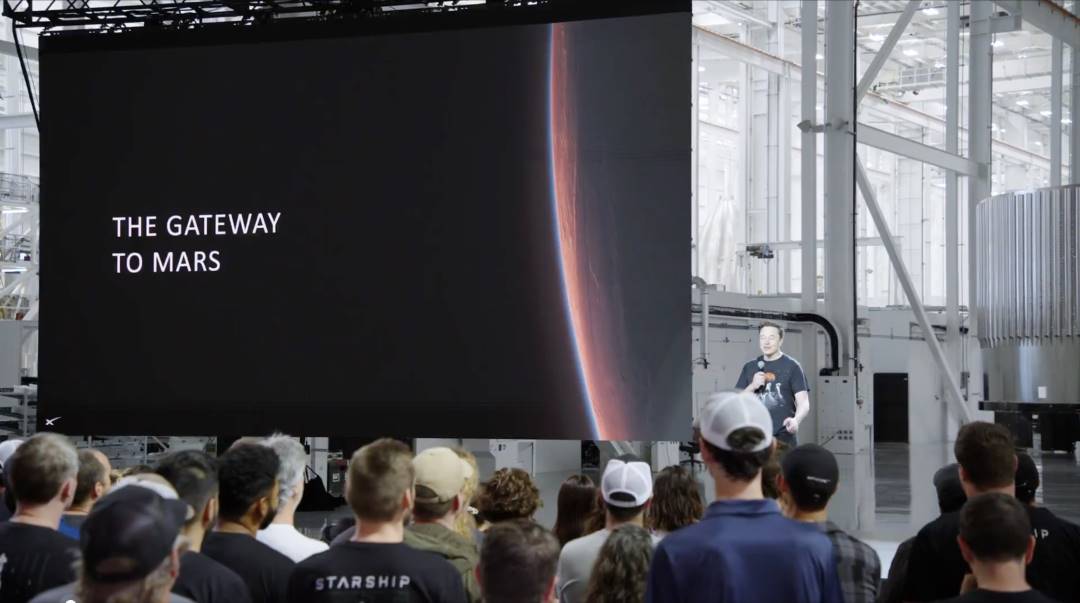
There is no worse moment than the first Starship explosion, yet Musk's dream of Mars continues. As he said:
You want to wake up every morning feeling that the future will be better—that's the essence of becoming a spacefaring civilization. It means having confidence in the future, believing that tomorrow will be better than today. And I can't think of anything more exciting than going to space and being among the stars.
Key points are summarized as follows:
SpaceX is expanding its production capacity, aiming to produce 1,000 Starships per year.
Even if Earth's supply is interrupted, SpaceX plans to enable Mars to develop self-sustainability, achieving "civilizational resilience," and potentially rescuing Earth if problems arise here.
The next key technology for SpaceX is to "catch" the Starship itself, with plans to demonstrate this technology later this year, expecting tests within two to three months. The Starship will be placed on top of the booster, refueled, and launched again.
The third-generation versions of the Starship, Raptor 3, and booster will have key capabilities such as rapid reusability, reliable operation, and orbital propellant refueling, expected to be realized in the Starship 3.0 version. The first launch is planned for the end of the year.
The upcoming rocket version is sufficient to support humanity's goal of multi-planetary existence, with future plans to continue improving efficiency, enhancing capabilities, reducing costs per ton, and lowering expenses for trips to Mars.
The launch window for Mars opens every 26 months, with the next one expected at the end of next year (about 18 months from now).
In the future Mars window period, SpaceX plans to send humans to Mars, provided that previous unmanned missions successfully land. If all goes well, the next launch will achieve a crewed landing on Mars and begin infrastructure development.
To ensure mission success, SpaceX may conduct an Optimus robot landing mission as a test for the third launch, ensuring the smooth execution of the crewed mission.
Here is the original video link:
https://x.com/SpaceX/status/1928185351933239641
Making Humanity a Multiplanetary Species
Alright, let's start today's speech. The gateway to Mars has been opened, and we are now at the newly established "Starbase" in Texas.
This should be the first new city built in the U.S. in decades, at least that's what I've heard. The name is also very cool; it's called this because we will develop the technology here that allows humanity, civilization, and the life we know to venture to another planet for the first time—unprecedented in Earth's 4.5 billion-year history.
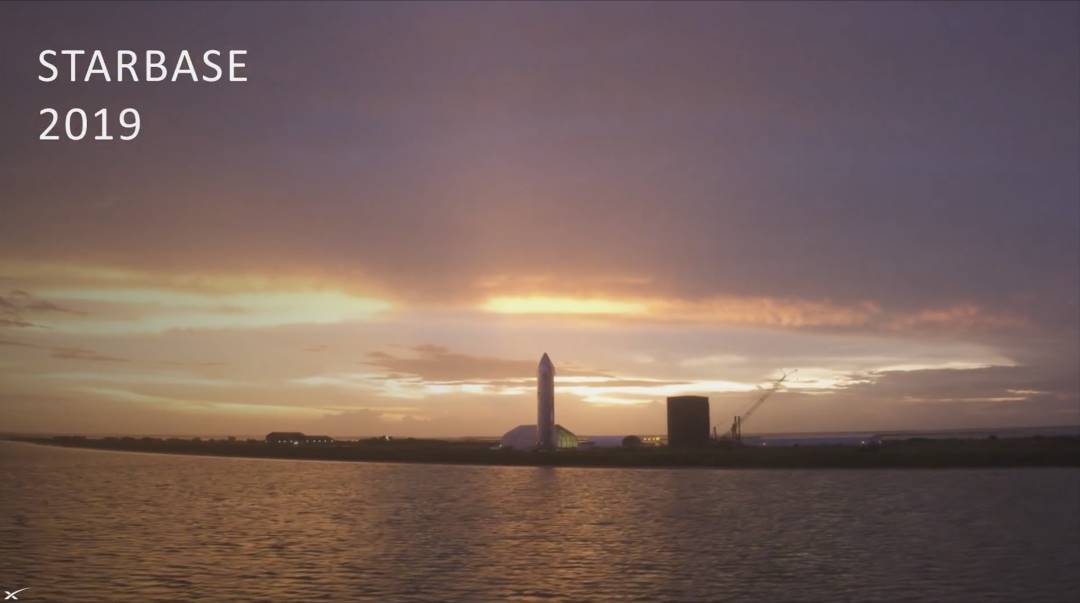
Let's take a look at this short video. At first, there was basically nothing here. Initially, it was just a sandbar. Nothing at all? Even those few small facilities we built were, of course, constructed later.
That was the original "Mad Max" rocket. It was at that time we realized how important it was to light up this "Mad Max" rocket.
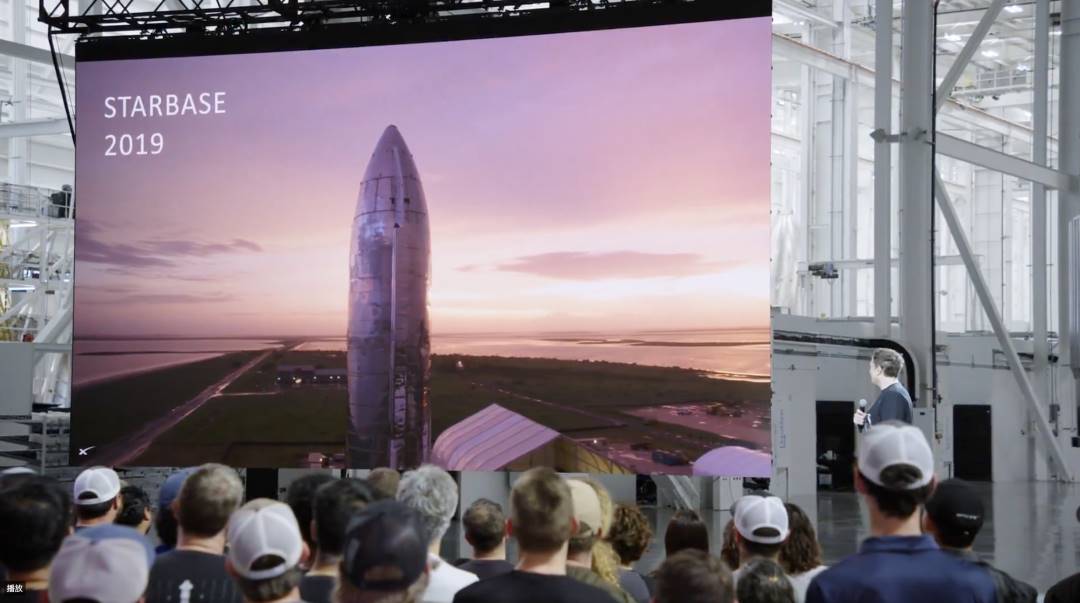
Yes, a few years ago, this place was still basically barren. And in just five or six years, thanks to the outstanding efforts of the SpaceX team, we built a small city, a giant launch platform, and a massive factory for manufacturing giant rockets.
Even better, anyone who sees this video can actually come and visit. Our entire production facility and launch site are located next to a public road. This means anyone coming to South Texas can see the rockets up close and tour the factory.
So, as long as you're interested in the largest flying machines on Earth, you can come anytime; just drive along that road, it's really cool. And now we have come to where we are today—Starbase, 2025.
We have now reached a level where we can manufacture a spacecraft approximately every two to three weeks. Of course, we don't produce one every two or three weeks on a fixed schedule, as we are still continuously upgrading designs. But our ultimate goal is to produce 1,000 spacecraft per year, which is three per day.
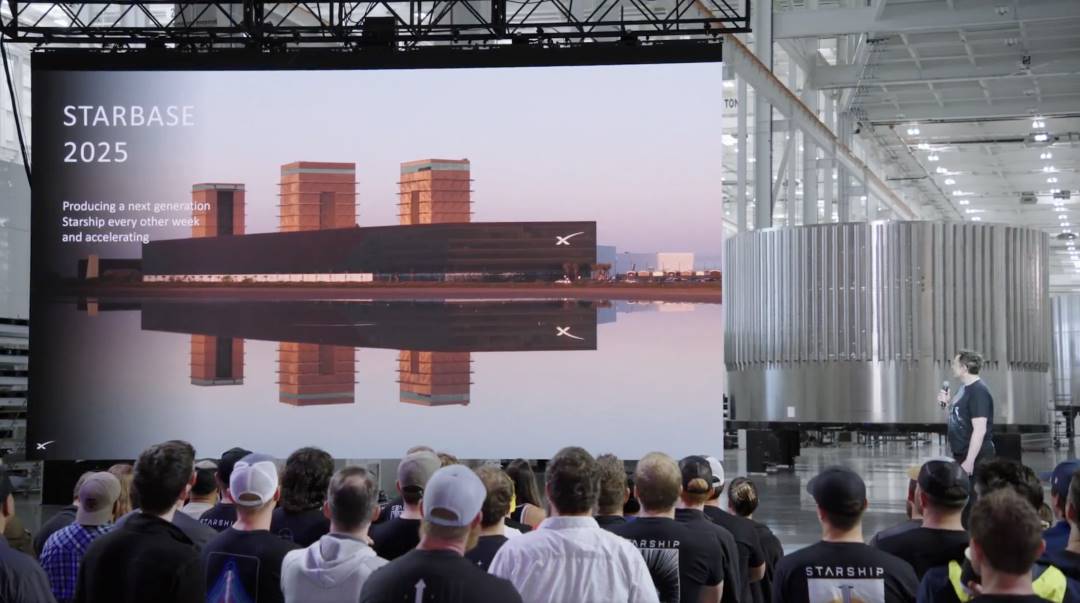
This is the current progress. I am now standing in that building. That is our air cushion vehicle. We are transporting a booster to the launch site, and you can see those mega bays.
As I mentioned earlier, the coolest thing for those watching this video is that you can actually come here directly, drive along this road, and see it all for yourself. This is the first time in history that such an opportunity exists. The road on the left is a public road. You can come and see it anytime; I highly recommend a visit, I think it's truly inspiring.
We are expanding our integration capabilities to achieve the goal of producing 1,000 Starships per year. Although it is not completed yet, we are building it. This is a true mega project, and by some standards, it may become one of the largest buildings in the world. Its design goal is to produce 1,000 Starships annually. We are also building another facility in Florida, so we will have two production bases in Texas and Florida.
It's actually hard to gauge how big these buildings are just by looking at them. You need to place a person next to them for comparison to truly realize their massive scale.
If we compare "the number of vehicles produced annually," like the number of airplanes manufactured by Boeing and Airbus, at some point in the future, the annual output of Starships may match that of Boeing and Airbus commercial aircraft. The scale of this project is truly enormous.
Moreover, each Starship's payload capacity far exceeds that of a Boeing 747 or Airbus A380; it can truly be described as a "behemoth."
Next is information about Starlink satellites, with an annual production of about 5,000 third-generation satellites, which may approach 10,000 in the future. Each third-generation satellite is roughly the size of a Boeing 737, which is very large. It's not an exaggeration to compare it to a B-24 bomber from World War II.
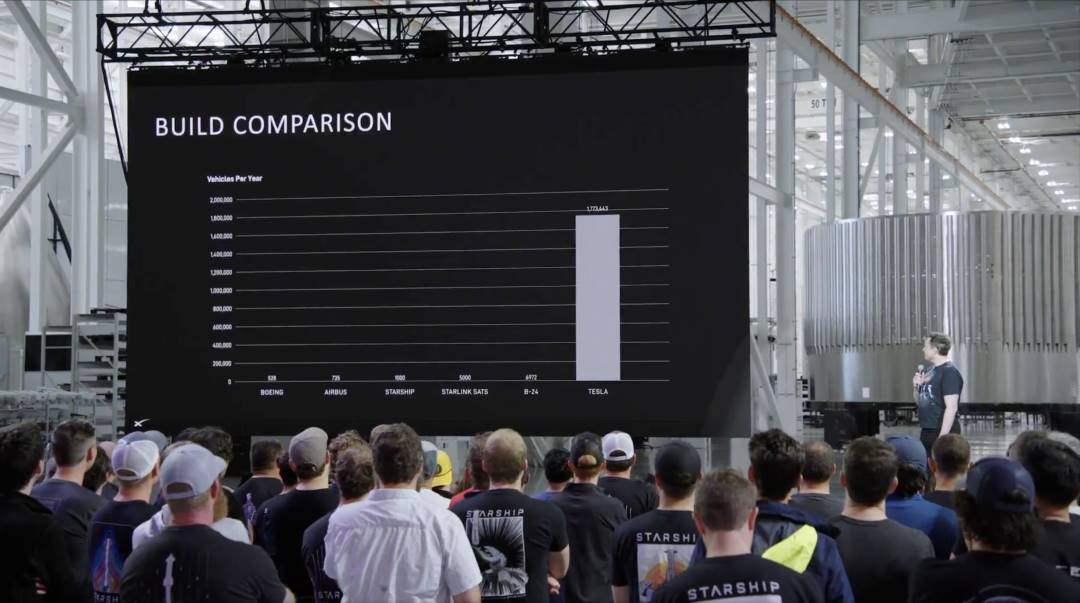
Of course, this scale is still small compared to Tesla. In the future, Tesla's annual production may be double or even triple this.
These comparisons help us establish a concept: manufacturing a large number of Starships for interstellar travel is feasible. Even from a total tonnage perspective, companies like Tesla and other automakers are still producing more complex and higher-volume products than SpaceX.
In other words, these seemingly exaggerated numbers are entirely achievable by humanity because other industries have already reached similar scales.
Our progress, measured by a standard, is the time required to achieve a self-sustaining civilization on Mars. Each launch of the Starship, especially in the early stages, is a continuous learning and exploration process, laying the foundation for humanity to become a multiplanetary species, allowing the Starship to improve continuously, ultimately sending thousands or even millions of people to Mars.
Ideally, anyone who wants to go to Mars can realize that dream, and we can also transport all the equipment needed for Mars to become self-sufficient, allowing society there to develop independently.
Even in the worst-case scenario, we must reach a critical turning point: even if Earth's supply is interrupted, Mars can continue to develop. At that point, we will have achieved "civilizational resilience"—even when serious problems arise on Earth, Mars may be able to rescue Earth.
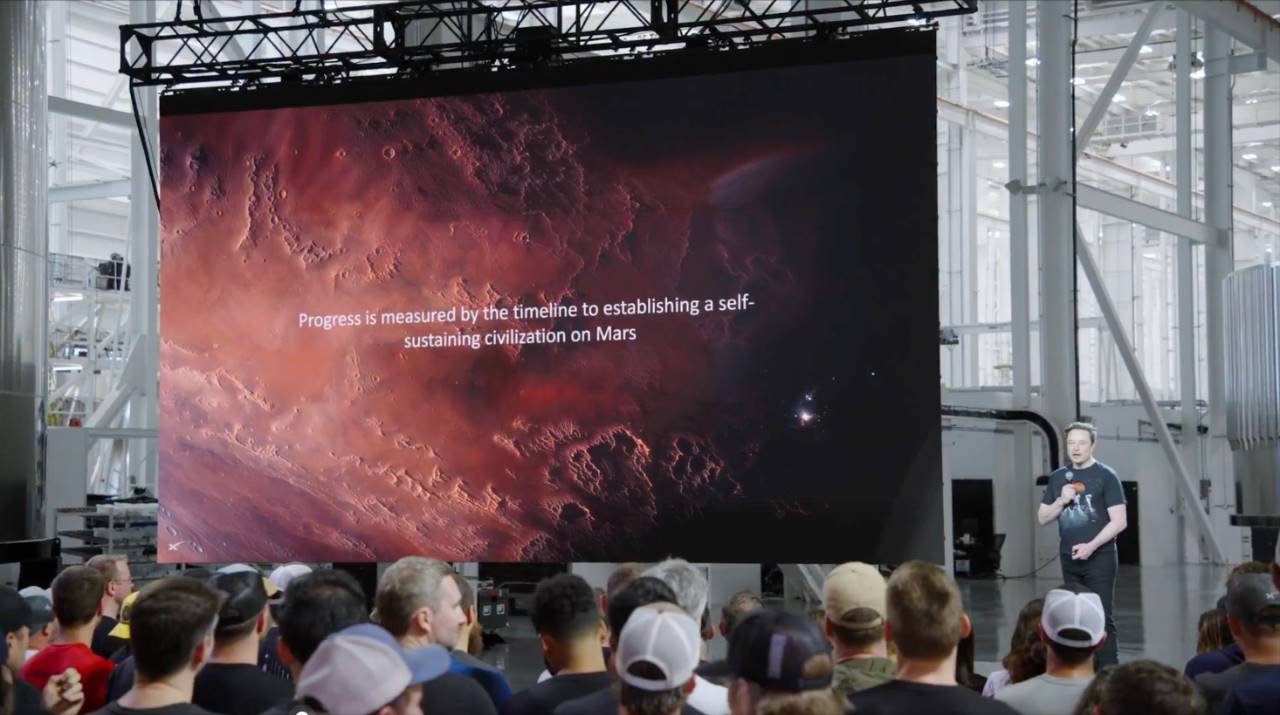
Of course, it could also be Earth aiding Mars. But the most important thing is that both planets can operate independently and coexist as powerful entities, which is crucial for the long-term survival of human civilization.
I believe that any civilization that is multiplanetary could extend its lifespan tenfold or even far beyond that. A single-planet civilization always faces some unpredictable threats, such as self-destructive conflicts—like a third world war (which we hope will never happen)—as well as natural disasters like asteroid impacts or supervolcanic eruptions.
If we only have one planet, once a disaster occurs, civilization could end; but if we have two planets, we can continue to exist and even expand further beyond Mars, such as to the asteroid belt, Jupiter's moons, or even farther, ultimately entering other star systems.
We can truly venture among the stars, making "science fiction" no longer just a fantasy.
To achieve this goal, we must create "rapidly reusable" rockets, keeping the cost of each flight and the cost per ton sent to Mars as low as possible. This requires rockets to have rapid reusability capabilities.
In fact, we often joke internally that it's like "rapid, reusable, reliable rockets," the three "R's," which sounds just like a pirate's call "RRRR," and the key is these three "R's."
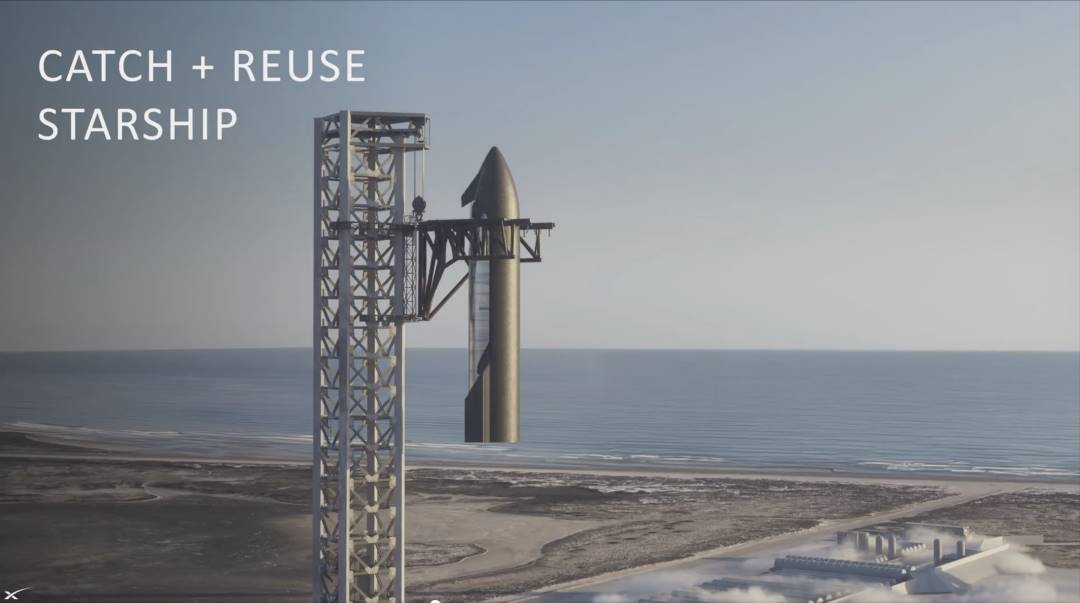
Now the SpaceX team has made astonishing progress in catching giant rockets.
Think about it, our team has successfully "caught" the largest flying machine ever made by humans multiple times, using a very novel method—catching it from the air with giant "chopsticks." This is truly an incredible technological breakthrough.
I want to ask, have you ever seen a scene like this before?
Once again, congratulations to everyone; this is truly an incredible achievement. The reason we are using this unprecedented method to "catch" the rocket is that it is crucial for achieving rapid reusability of the rocket.
The Super Heavy Booster is massive, with a diameter of about 30 feet (approximately 9 meters). If it lands on the platform with landing legs,
we would still need to lift it up, retract the landing legs, and place it back on the launch pad, which is quite a complex operation. However, if we can use the same tower—the one that originally installed it on the launch pad—to directly catch it from the air and return it to its original position, that would be the best solution for achieving rapid reusability.
In other words, the rocket is caught by the same pair of mechanical arms that originally placed it in the launch pad and is then immediately returned to the launch position.
Theoretically, the Super Heavy Booster could be ready for re-launch within an hour after landing.
The flight itself only takes 5 to 6 minutes, after which it is caught by the tower arm and placed back on the launch pad. It would take about another 30 to 40 minutes to replenish the propellant and then place the spacecraft back on top—principally, this means we could achieve a launch every hour, or at most, every two hours.
This is the ultimate state of rocket reusability.
The next major task we need to accomplish is to "catch" the Starship itself. We haven't achieved this yet, but we will definitely make it happen.
We hope to demonstrate this technology later this year, possibly testing it within the next two to three months. After that, the Starship will be placed on top of the booster, refueled, and launched again.
However, the re-flight time for the Starship will be slightly longer than that of the booster, as it needs to orbit the Earth a few times until its flight path returns over the launch site. Nevertheless, the Starship is also planned to achieve multiple flights per day.
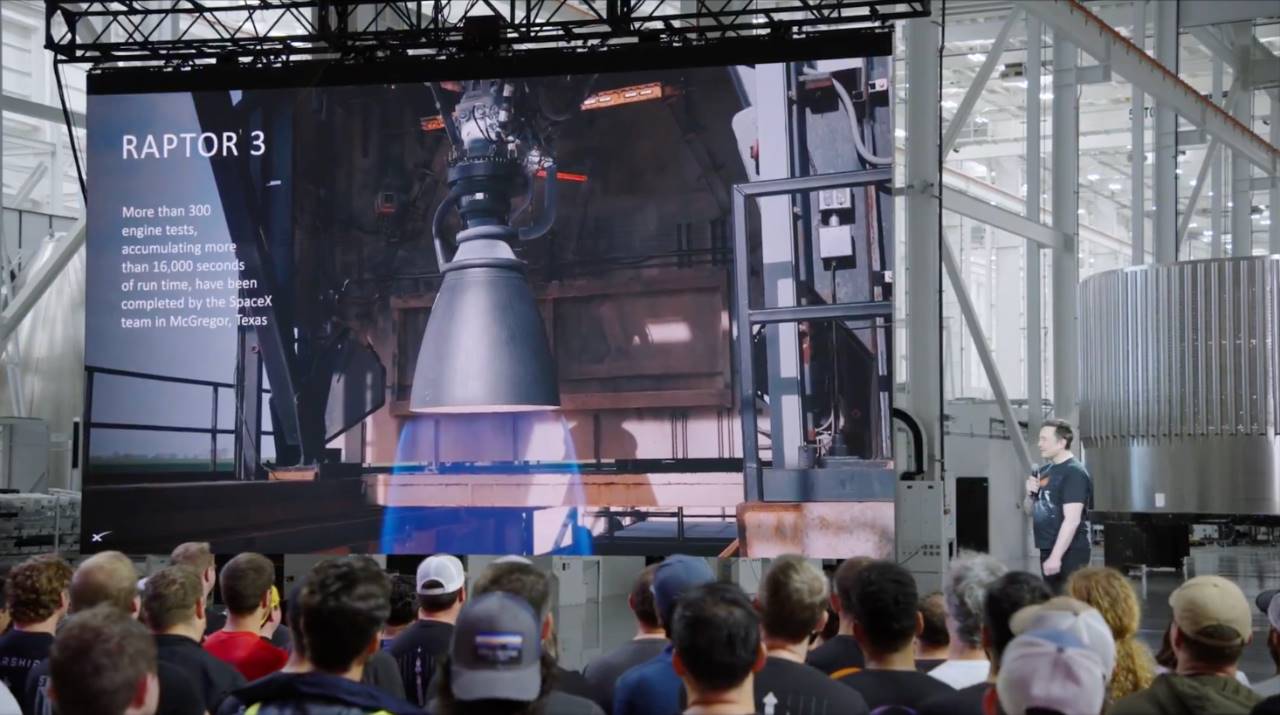
This is the new generation of Raptor 3 engines, which perform exceptionally well. We must give a shout-out to the Raptor team; this is truly exciting.
The design concept of Raptor 3 eliminates the need for a traditional heat shield, significantly saving weight at the engine's base while also improving reliability. For example, if there is a small fuel leak in the Raptor engine, the fuel will leak directly into the already hot plasma, which essentially causes no issues. However, if the engine were enclosed in a structural box, such a leak would be very dangerous.
So, this is Raptor 3. We may need to conduct several more tests, but this engine represents a significant leap in payload capacity, fuel efficiency, and reliability. It can be said to be a revolutionary rocket engine.
I would even say that Raptor 3 is almost like a product of "alien technology."
In fact, when we first showed the image of Raptor 3 to industry experts, they said that the engine was not fully assembled. We then told them: this is the "not fully assembled" engine, which has already achieved unprecedented levels of efficiency and is operational.
Moreover, its operational state is extremely clean and stable.
To create such an engine, we simplified the design significantly. For instance, we integrated the secondary fluid circuits, electrical circuits, and more directly into the engine structure. All key systems are well encapsulated and protected. Frankly, this is already a model of engineering design.
Another technology crucial for achieving Mars missions is—orbital propellant refueling. You can think of it as similar to "air refueling," but this time it's "orbital refueling," targeting rockets. This technology has never been realized in history, but it is technically feasible.
Although this process may seem a bit "not suitable for children," the fact is that propellant must be transferred; there's no way around it; this step must be completed.
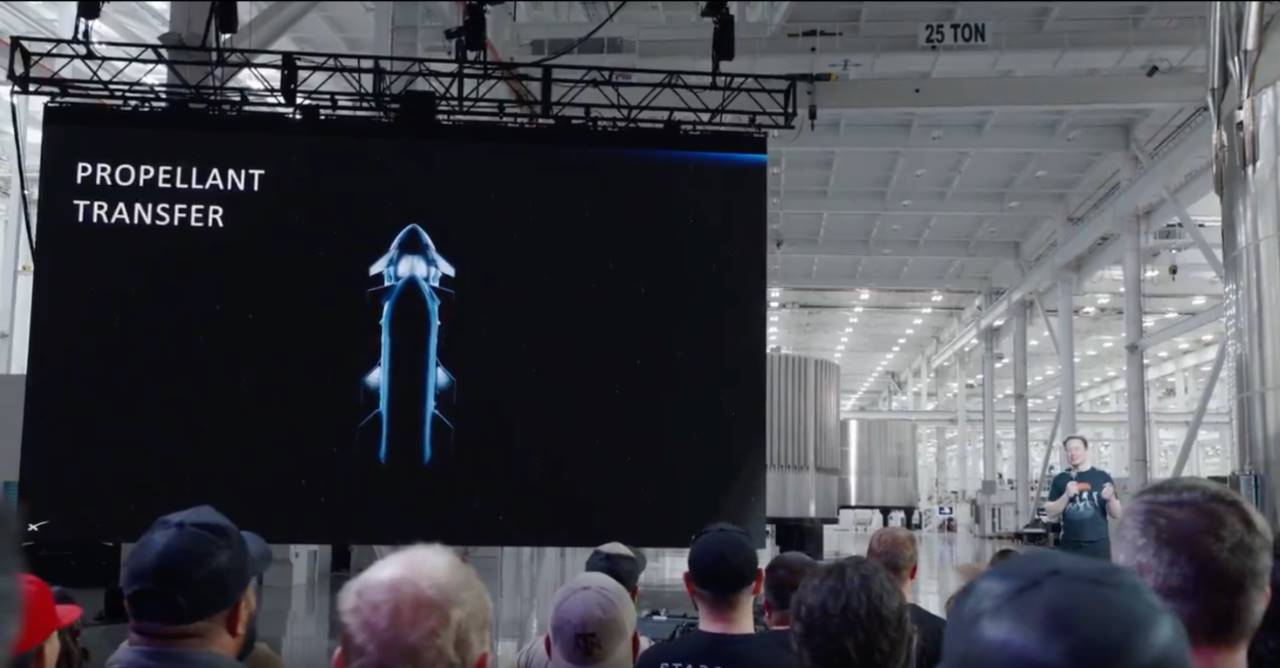
Specifically, it involves two Starships docking in orbit, with one Starship transferring propellant (fuel and oxygen) to the other. In fact, most of the mass is oxygen, which accounts for nearly 80%, while fuel only accounts for about 20%.
So, our strategy is: first launch a Starship filled with cargo into orbit, and then launch several "refueling-specific" Starships to fill it up through orbital refueling. Once the propellant is replenished, that Starship can set off for Mars, the Moon, or other destinations.
This technology is very critical, and we hope to complete the first demonstration next year.
One of the most challenging problems to solve next is the "reusable heat shield."
Currently, no one has truly developed a reusable orbital heat shield. This is an extremely difficult technical challenge. Even the space shuttle's heat shield required months of maintenance after each flight—to repair damaged heat tiles and inspect them piece by piece.
This is because the high temperatures and pressures during re-entry are extremely harsh, and very few materials can withstand such extreme environments, mainly advanced ceramics like glass, alumina, or certain types of carbon materials.
However, most materials either corrode, crack, or flake off after multiple uses, making it difficult to endure the immense pressure during re-entry.
This will be humanity's first true development of a "reusable orbital heat shield system." This system must be extremely reliable. We expect to continue refining and optimizing it over the next few years.
However, this technology is achievable. We are not pursuing an impossible task; it is feasible within the realm of physics—it’s just very, very difficult to implement.
As for Mars' atmosphere, although it is primarily composed of carbon dioxide, it may seem "milder" than Earth's at first glance, but the reality is worse.
When carbon dioxide becomes plasma during re-entry, it breaks down into carbon and oxygen—this means that the free oxygen content in Mars' atmosphere could be higher than that of Earth. Earth's atmosphere contains about 20% oxygen, while Mars, after plasma decomposition, could have oxygen levels two to three times that of Earth.
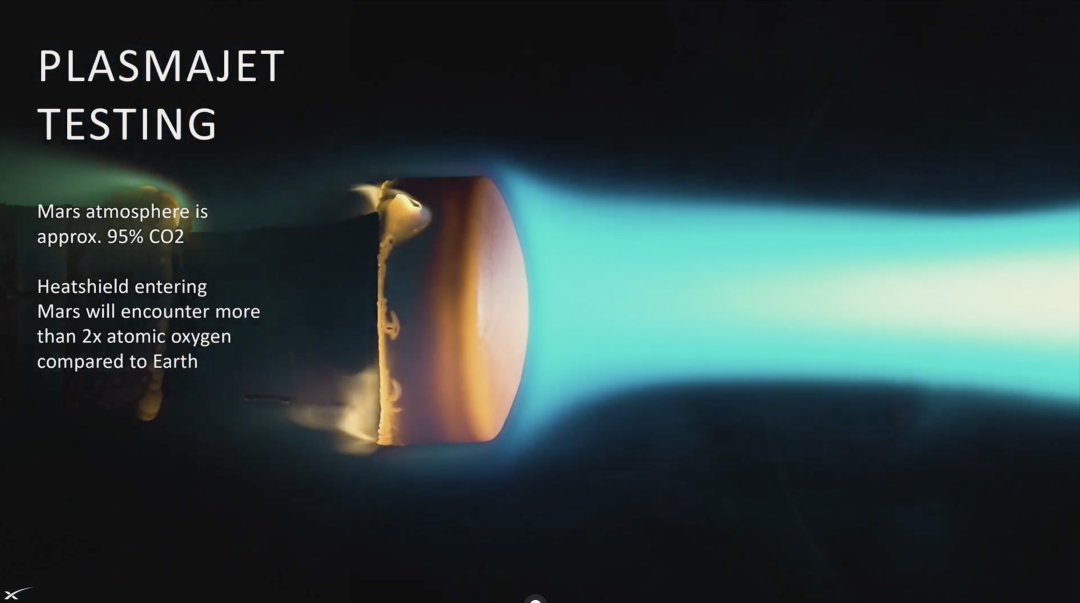
And this free oxygen will aggressively oxidize the heat shield, almost "burning" it away. Therefore, we must conduct very rigorous testing in a carbon dioxide environment to ensure that it is not only effective on Earth but also reliable on Mars.
We hope to use the same heat shield system and materials for both Earth and Mars. Because the heat shield involves many technical details, such as ensuring that the heat tiles do not crack or fall off, if we conduct hundreds of tests using the same materials on Earth, we can be confident that it will work properly when we actually fly to Mars.
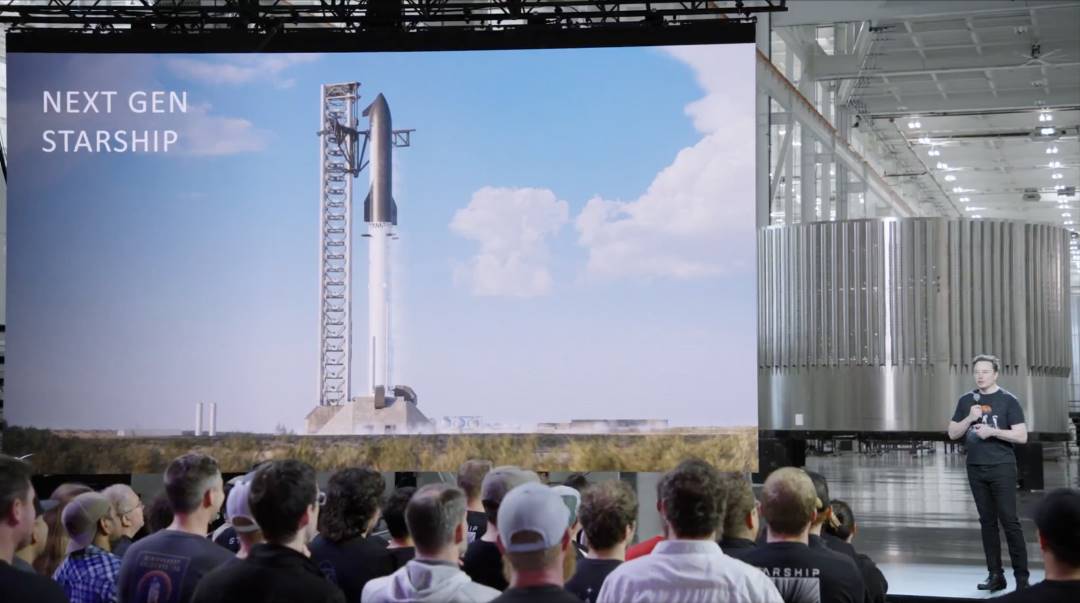
Additionally, we are developing the next generation of Starship, which has many improvements compared to the current version.
For example, the new generation of Starship is taller, and the "interstage" structure between the spacecraft and the booster is designed more rationally. You can see the new support structures, which make the "hot staging" process smoother.
Hot staging refers to igniting the Starship's engines while the booster is still burning. This way, the flames from the Starship's engines can exit more smoothly through these open support structures without interfering with the booster.
Moreover, this time, we will not discard these structures as we did before; instead, we will let them fly with the Starship, achieving reusability.
This version of the Starship has slightly increased in height, from the original 69 meters to 72 meters. We expect the propellant capacity to increase slightly, potentially reaching 3,700 tons in the long term. My guess is that it will ultimately approach 4,000 tons.
In terms of thrust, or the "thrust-to-weight ratio," we may reach 8,000 tons of thrust, and even eventually go up to 8,003 tons—this is during the continuous optimization process. My estimate is that we will ultimately achieve a configuration of 4,000 tons of propellant and close to 10,000 tons of thrust.
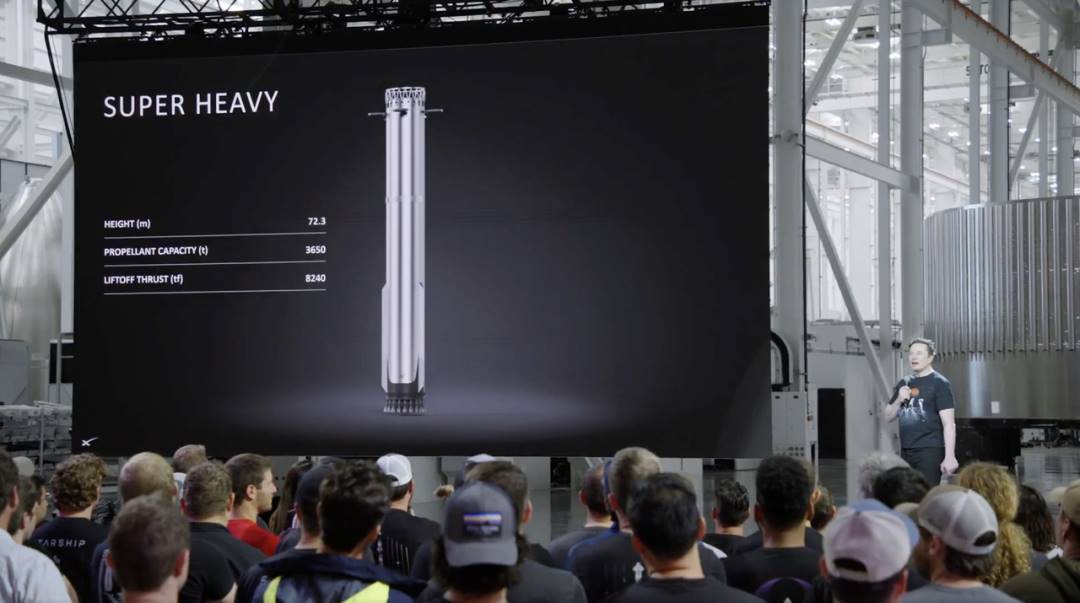
This is the next generation, the new version of the Super Heavy Booster.
The bottom of the booster may look a bit "bare" because the Raptor 3 engines do not require a heat shield, so it seems like something is missing, but in fact, that is just because these engines do not need the original protective structures.
The Raptor 3 is directly exposed to the hot plasma, but it is designed to be very lightweight and does not require additional insulation.
This system also integrates the hot stage separation structure, which I think looks very cool. The new version of the Starship's body is also slightly longer, with enhanced capabilities, and the propellant capacity increased to 1,550 tons. In the long term, it may be about 20% more than this.
The design of the heat shield is also smoother, transitioning from the edge of the heat layer to the leeward side very smoothly, no longer featuring the uneven heat tiles. I think it looks very clean and elegant.
Currently, this version still carries 6 engines, but future versions will upgrade to 9 engines.
Thanks to the improvements in Raptor 3, we have achieved lower engine mass and higher specific impulse, meaning greater efficiency. Starship Version 3 represents a significant leap. I believe it achieves all our core goals:
Typically, a new technology needs to go through three generations of iteration to truly mature and be user-friendly. The Raptor 3, Starship, and the third generation of the booster will possess all the key capabilities we need: rapid reusability, reliable operation, and orbital propellant refueling.
These are all necessary conditions for humanity to become a multiplanetary species, and all of this will be realized in Starship 3.0. We plan to launch it for the first time at the end of this year.
You can see that on the left is the current state, in the middle is our target version for the end of this year, and on the right is the long-term development direction. The final height will reach about 142 meters.
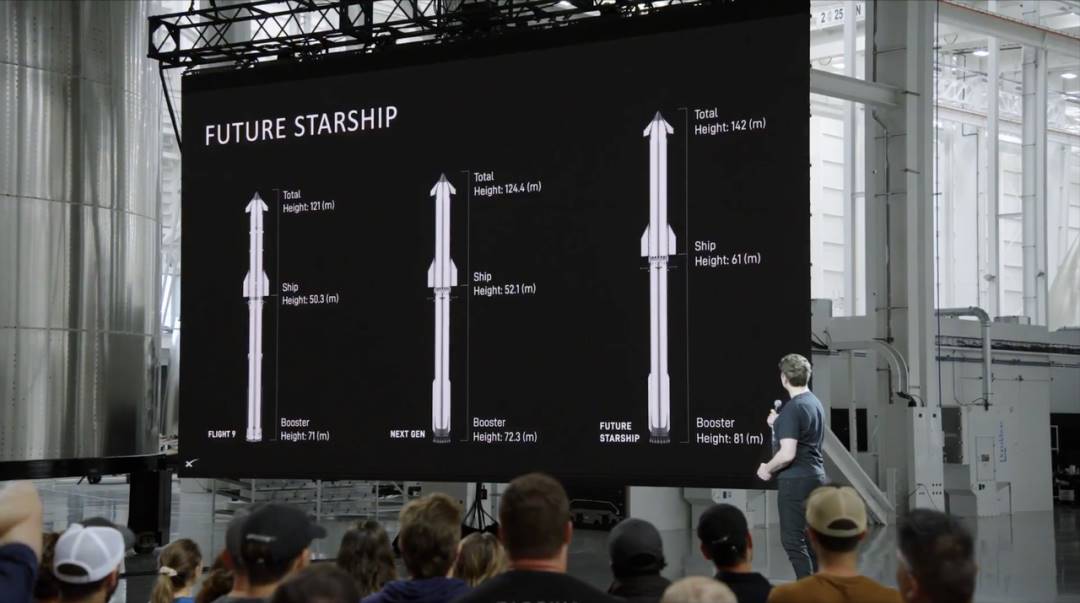
But even the version that will be launched at the end of this year already fully possesses the capability to execute Mars missions. Subsequent versions will further enhance performance. Just like what we did with Falcon 9 in the past, we will continuously extend the rocket and improve its payload capacity. This is our development roadmap, simple and clear.
But I want to emphasize that the rocket version set to launch at the end of the year is already sufficient to support humanity's goal of multi-planetary existence. What we need to do next is to continue improving efficiency, enhancing capabilities, reducing costs per ton, and making the expenses for each person traveling to Mars lower.
As I mentioned before—our goal is to enable anyone who wants to move to Mars and participate in building a new civilization to do so.
Just think about how cool that would be! Even if you don’t want to go yourself, perhaps you have a son, daughter, or friend who would be willing to go. I believe this will be one of the greatest adventures humanity can participate in—going to another planet and building a new civilization with our own hands.
Yes, ultimately our Starship will be equipped with 42 engines—this seems almost destined, just as the great prophet Douglas Adams predicted in his book "The Hitchhiker's Guide to the Galaxy": the ultimate answer to life is 42.
So, the Starship will indeed have 42 engines; that is the arrangement of the universe (laughs).
Now, let's talk about payload capacity. The most astonishing thing is that, under fully reusable conditions, the Starship will have a low Earth orbit capacity of 200 tons. What does that mean? That is equivalent to twice the payload capacity of the Saturn V lunar rocket. And the Saturn V was a single-use rocket, while the Starship is fully reusable.
If the Starship were also a single-use vehicle, its low Earth orbit capacity could even reach 400 tons.
So what I want to say is: this is a very large rocket. But to achieve "human multi-planetary existence," we must have such a large rocket. And in the process of achieving Mars colonization, we can also do many cool things, such as establishing a base on the Moon—Lunar Base Alpha.
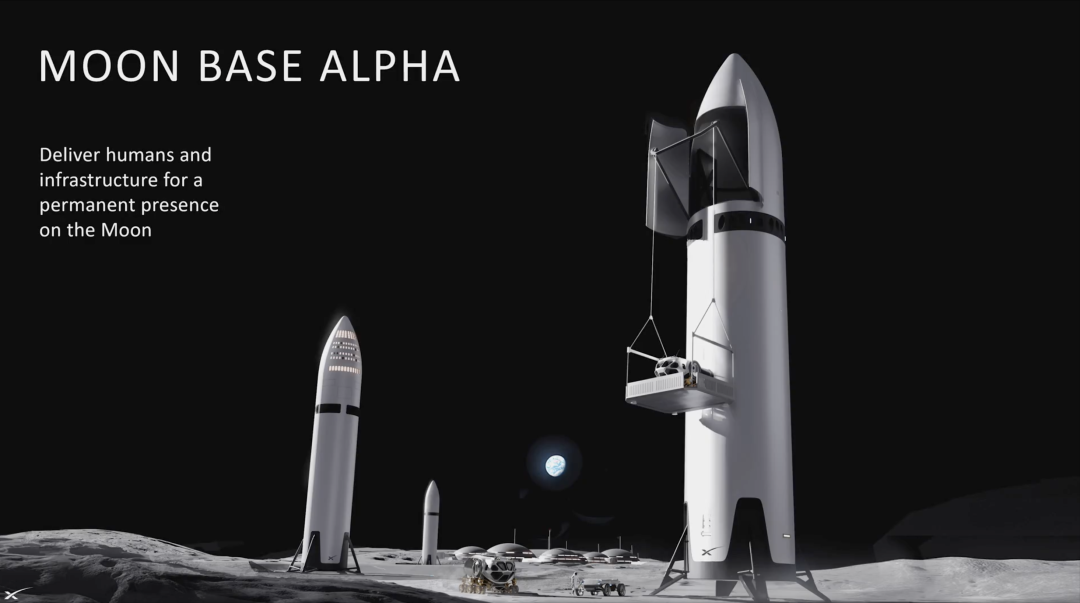
A long time ago, there was a TV show called "Lunar Base Alpha." Although some of the physics in the show was not very reliable—like the lunar base seemingly drifting away from Earth's orbit (laughs)—establishing a base on the Moon should be the next step after the Apollo lunar landing program.
Imagine if we could build a giant scientific station on the Moon to conduct research on the nature of the universe; that would be very cool.
So, when can we go to Mars?
The Mars launch window opens every two years, specifically every 26 months. The next Mars window will be at the end of next year, which is about 18 months from now, around November or December.
We will strive to seize this opportunity. If luck is on our side, I think we currently have about a 50/50 chance of achieving our goal.
The key to accomplishing the Mars mission lies in whether we can complete the orbital propellant refueling technology in time. If we can finish this technology before the window opens, we will launch the first unmanned Starship to Mars at the end of next year.
Next, you will see a demonstration diagram showing how the flight from Earth (blue) to Mars (red) is achieved.
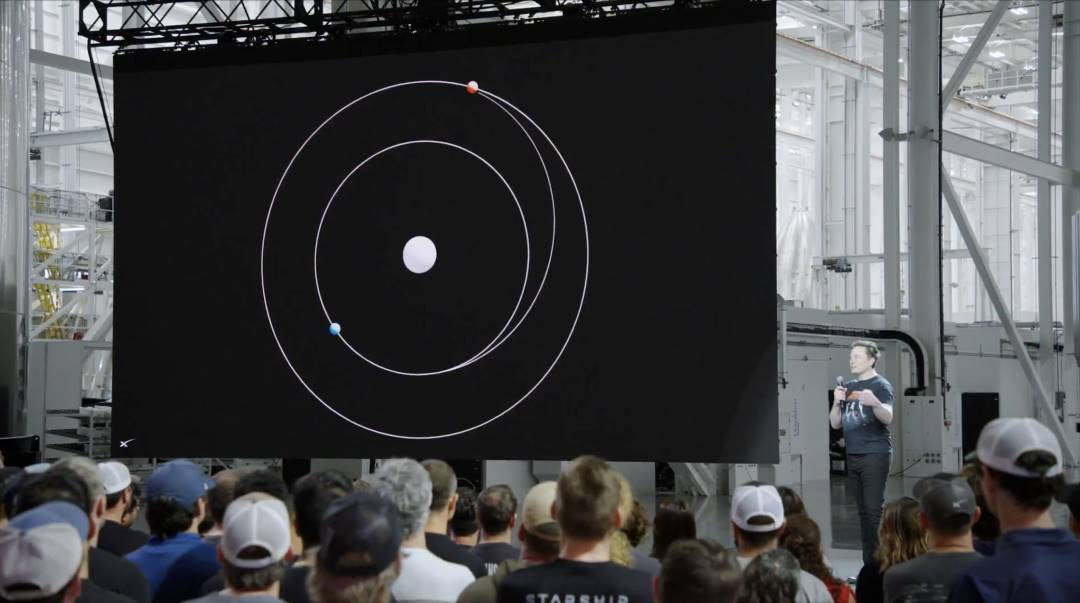
In fact, the distance traveled on the flight trajectory from Earth to Mars is nearly thousands of times that to the Moon.
You cannot just "fly straight" to Mars; you must transfer along an elliptical orbit—Earth is at one focus of this ellipse, and Mars is at the other end of the orbit. You also need to precisely calculate the spacecraft's position and timing in orbit to ensure it can intersect with Mars' orbit.
This is known as the Hohmann Transfer, which is the standard way to travel from Earth to Mars.
If you have a Starlink Wi-Fi router, you can look at the logo pattern above; it illustrates this orbital transfer. The satellite internet service provided by Starlink is one of the projects helping to fund humanity's journey to Mars.
So I want to especially thank everyone using Starlink—you are helping to ensure the future of human civilization, helping humanity become a multi-planetary civilization, and helping humanity enter the "era of space exploration." Thank you.
This is a preliminary plan blueprint: we hope to significantly increase the frequency of flights to Mars and the number of spacecraft with each opening of the Mars launch window (approximately every two years).
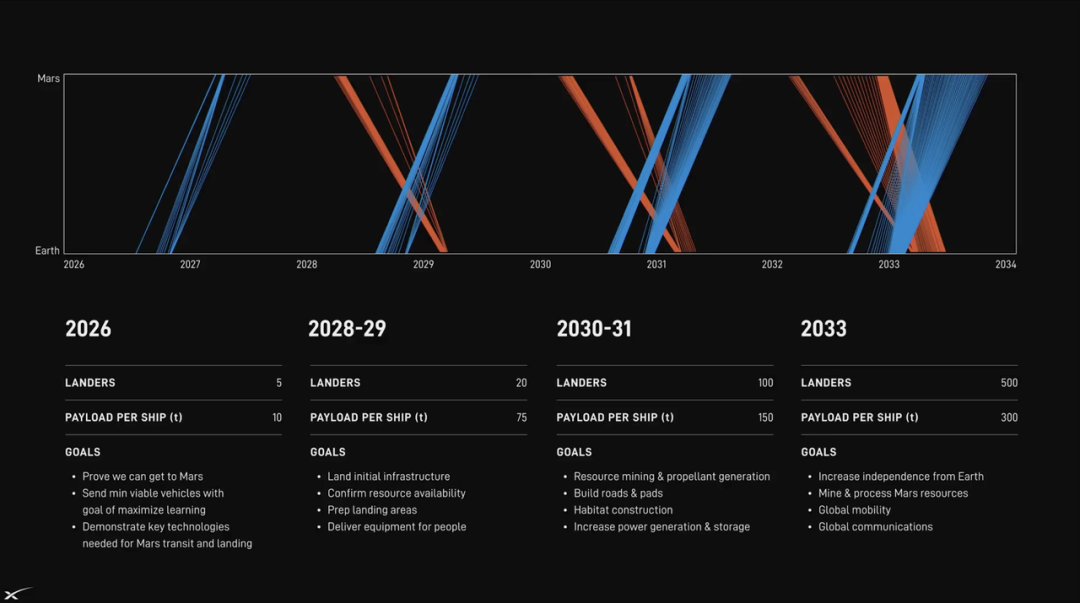
Ultimately, our goal is to launch 1,000 to 2,000 Starships to Mars with each Mars window. Of course, this is just a rough estimate in terms of magnitude, but based on my judgment, to establish a self-sustaining civilization on Mars, we will need to send about 1 million tons of supplies to the Martian surface.
Only when Mars has such foundational capabilities can we truly reach a "civilization safety point"—meaning that even if Earth can no longer continue to supply resources, Martian civilization can survive and develop independently.
For this, you cannot lack anything, even small but crucial elements like vitamin C. Mars must have everything it needs to achieve true growth.
I estimate that we will need about 1 million tons, possibly even 10 million tons; I hope it won't be 100 million tons, as that would be too much. But in any case, we will do everything we can to reach this goal as soon as possible to ensure the future of human civilization.
We are currently evaluating multiple candidate locations for Martian bases, with the Arcadia region being one of the top choices. There are many "land" resources on Mars, but after considering various factors, the selection range becomes quite small:
For example, it cannot be too close to the poles (as the environment is too extreme), it needs to be near ice layers to access water sources, and the terrain should not be too rugged to allow for safe rocket landings.

Considering these factors, Arcadia is one of the more ideal locations. By the way, my daughter's name is also Arcadia.
In the initial phase, we will send the first batch of Starships to Mars to collect critical data. These spacecraft will carry Optimus humanoid robots, which will arrive first, explore the surrounding environment, and prepare for human arrival.
If we can indeed launch the Starship at the end of next year and successfully reach Mars, it will be a stunning sight. According to the orbital cycle, that spacecraft will arrive at Mars in 2027.
Imagine the scene of Optimus humanoid robots walking on the Martian surface; that will be a historic moment.
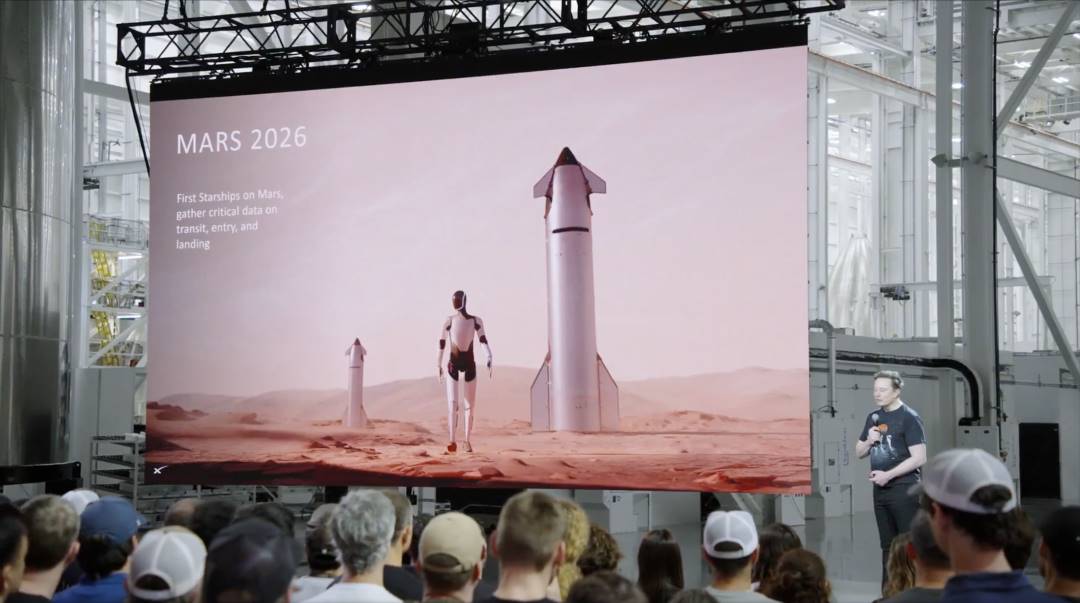
Then, in the next Mars window two years later, we will attempt to send humans to Mars, provided that the previous unmanned missions successfully land. If all goes well, we will have humans set foot on Mars in the next launch, truly beginning to build infrastructure on Mars.
Of course, to be more cautious, we may also conduct another landing mission with the Optimus robots, making the third launch a crewed mission. It will depend on the actual results of the first two missions.
Do you remember that famous photo?—Workers sitting on a steel beam having lunch atop the Empire State Building. We hope to capture a similar iconic image on Mars. For Martian communications, we will use a version of the Starlink system to provide internet service.
Even with light-speed transmission, the delay between Earth and Mars is quite noticeable—ideally about 3.5 minutes, and in the worst-case scenario, when Mars is on the opposite side of the Sun, the delay can be as high as 22 minutes or more.
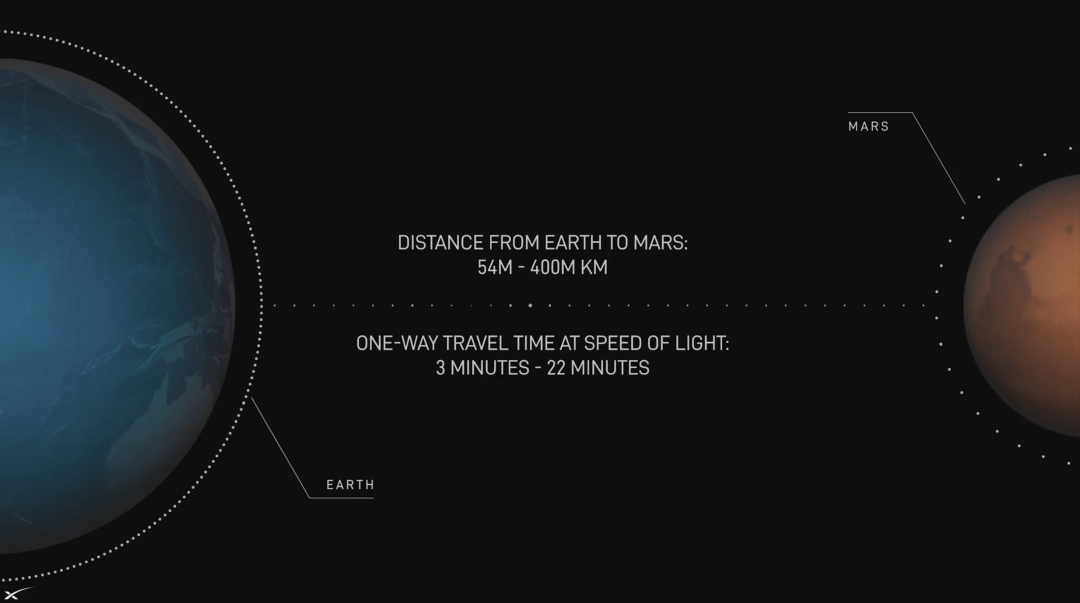
So, high-speed communication between Mars and Earth is indeed a challenge, but Starlink has the capability to solve this problem.
Next, the first group of humans will lay the groundwork on Mars, establishing a long-term stationed outpost. As I mentioned earlier, our goal is to enable Mars to achieve self-sustaining capabilities as soon as possible.
This image is our rough concept for the first city on Mars.
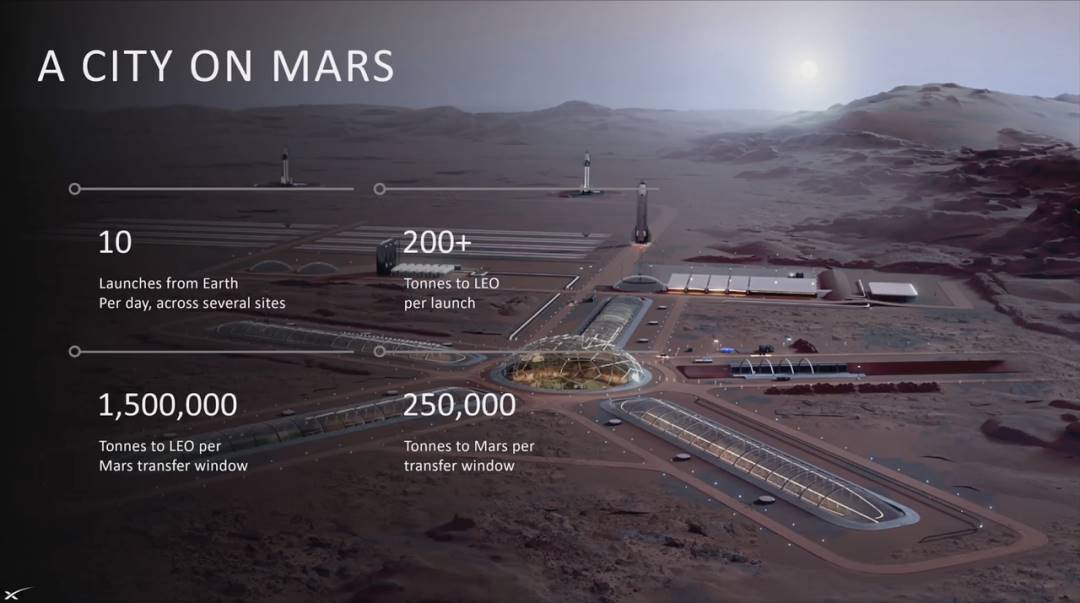
I speculate that we will build the launch pad a bit farther from the landing area to prevent accidents. On Mars, we will rely heavily on solar energy. In the early stages on Mars, as it has not yet been "terraformed," humans will not be able to walk freely on the Martian surface and must wear "Mars suits," living in enclosed structures similar to glass domes.
However, all of this is achievable. Ultimately, we have hope to transform Mars into an Earth-like planet.
Our long-term goal is to transport over one million tons of supplies to Mars with each Mars transfer window (approximately every two years). Only when we reach this level can we truly begin to build a "serious Martian civilization"—transporting "millions of tons" of supplies with each window is our ultimate standard.
At that time, we will need a large number of spaceports. Since flights cannot occur at any time and can only be concentrated during launch windows, we will have thousands, even up to two thousand Starships gathering in Earth orbit, waiting to launch simultaneously.
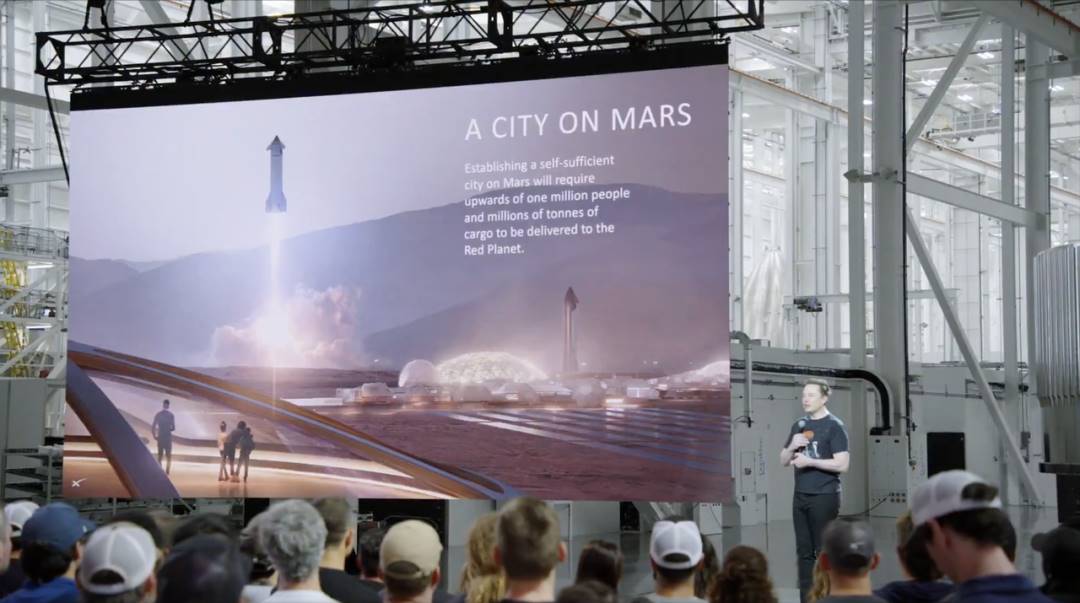
Imagine—like in "Battlestar Galactica," thousands of spacecraft gathering in orbit, all launching towards Mars at the same time; that will be one of the most spectacular scenes in human history.
Of course, by then we will also need a large number of Martian landing pads and launch pads. If thousands of Starships are flying in, you will need at least hundreds of landing spots, or you must efficiently clear the landing area quickly after landing.
We will solve this problem later (laughs). In any case, establishing humanity's first extraterrestrial city on Mars will be an incredible feat. This is not just a new world; it is also an opportunity—Martian residents can rethink the model of human civilization:
What form of government do you want?
What new rules would you like to establish?
On Mars, humanity has the freedom to rewrite the structure of civilization.
This is a decision for the "Martians."
So, alright—let's go and make this happen together.
Thank you, everyone!
免责声明:本文章仅代表作者个人观点,不代表本平台的立场和观点。本文章仅供信息分享,不构成对任何人的任何投资建议。用户与作者之间的任何争议,与本平台无关。如网页中刊载的文章或图片涉及侵权,请提供相关的权利证明和身份证明发送邮件到support@aicoin.com,本平台相关工作人员将会进行核查。




